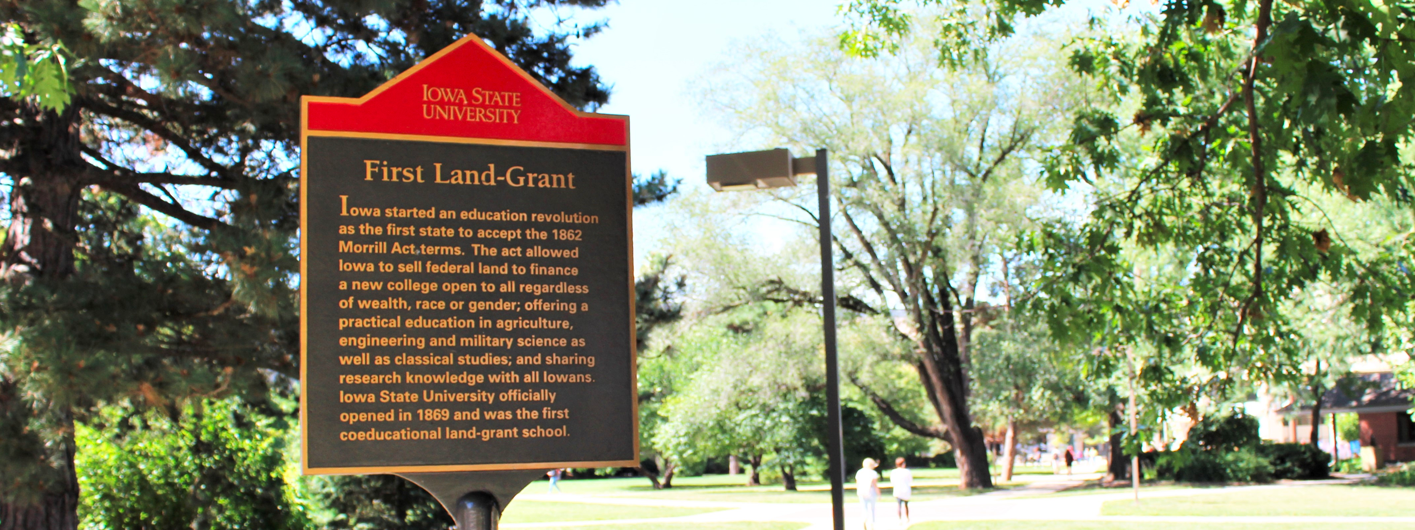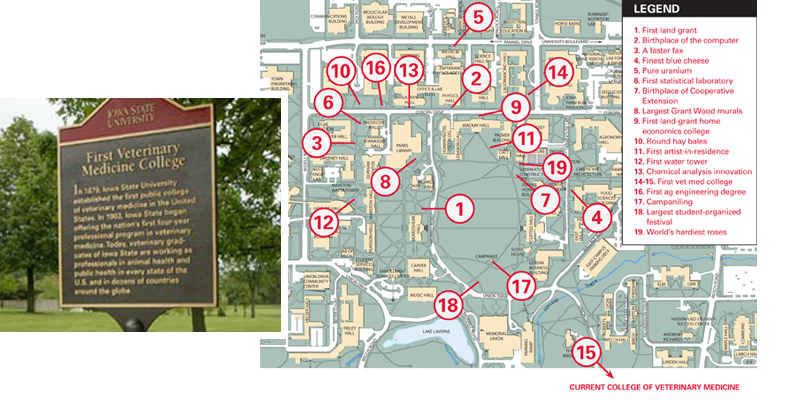Historical Signs build our reputation

As the first land-grant university in the nation, Iowa State has a rich heritage of educating students, discovering new knowledge, and sharing that knowledge to make Iowa and the world a better place. The university’s historical sign program commemorates those discoveries, inventions, events, and traditions on campus that make Iowa State unique and one of the best institutions in the nation in fulfilling its land-grant responsibilities.
Each sign is required to represent a topic that has societal impact and is a “wow” for those pedestrians who read it, regardless of their familiarity with Iowa State. Coordinated by the Office of University Marketing and funded by the Office of the President, the program consists of 19 signs (see map). The subjects for the signs were submitted by academic departments and other units on campus. Together, they tell campus visitors, students, faculty, and staff about the university’s rich tradition of national and international achievement and excellence.

The Signs
1. First Land Grant
Location: Near Beardshear Hall
Iowa started an education revolution as the first state to accept the 1862 Morrill Act terms. The act allowed Iowa to sell federal land to finance a new college open to all regardless of wealth, race, or gender, offering a practical education in agriculture, engineering, and military science, as well as classical studies and sharing research knowledge with all Iowans. Iowa State University officially opened in 1869 and was the first coeducational land-grant school.
2. Birthplace of the Computer
Location: Near Physics Building
The world’s first electronic digital computer was built on the Iowa State campus from 1939 through 1942 by John V. Atanasoff, a professor of physics and mathematics, and Clifford Berry, an engineering graduate student. Principles used in the Atanasoff-Berry computer are the basis of modern computing, and Atanasoff is now considered the father of the computer.
3. A Faster Fax
Location: Near Coover Hall
In 1971, Iowa State electrical engineering doctoral student David Nicholas invented a process to more efficiently convert text into digital information. Facsimile machine manufacturers adopted the technology in the 1980s, making fax machines an office staple for business correspondence around the world.
4. Finest Blue Cheese
Location: Near Food Sciences Building
Iowa State is home to the process that produces the world’s finest blue cheese. In 1937, Iowa State dairy microbiology professors Clarence Lane and Bernard Hammer developed a blue cheese process using homogenized milk. The Lane and Hammer process is now the standard for the blue cheese industry.
5. Pure Uranium
Location: Near Wilhelm Hall
In 1942, a group of Iowa State scientists led by professors Frank Spedding and Harley Wilhelm developed the process to produce highly pure uranium. More than 2,000,000 pounds of uranium were produced at Iowa State for the secret Manhattan Project, advancing the nation’s wartime efforts. The success of the Ames process led to the establishment of the Ames Laboratory at Iowa State.
6. First Statistical Laboratory
Location: Near Snedecor Hall
Established in 1933, the Statistical Laboratory at Iowa State was the first research and consulting institute of its kind in the country. Early emphasis on agriculture data analysis has continued; however, the laboratory’s range of activities now includes statistical applications in social, physical, engineering, and biological sciences for clients worldwide.
7. Birthplace of Cooperative Extension
Location: Between Catt Hall and Curtiss Hall
In 1903, the nation’s first cooperative agricultural extension program was launched when Iowa State professor Perry Holden, a group of farmers in Sioux County, and the county’s board of supervisors created a plan for educating farmers about improving seed corn. This massive effort included demonstration farms, farmer institutes, and special seed corn exhibit trains traveling from town to town on Iowa’s railroads. Cooperative extension nationwide is the result of this model of support and funding.
8. Largest Grant Wood Murals
Location: Near Parks Library
Grant Wood’s largest murals are located in Iowa State’s Parks Library. Wood, best known for his painting American Gothic that depicts a stoic farm couple, was commissioned by Iowa State in the mid-1930s to design Breaking the Prairie Sod and When Tillage Begins. A native Iowan, Wood is considered a leading exponent of American Regionalist art.
9. First Land-Grant Home Economics College
Location: Near MacKay Hall
In 1871, Iowa State became the first land-grant institution in the nation to teach domestic science. In 1872, Mary B. Welch, wife of Iowa State President Adonijah Welch, became the first domestic science instructor, giving lectures to support laboratory classes in kitchen, dining room, and laundry. From these beginnings grew the nation’s first land-grant college of family and consumer sciences.
10. Round Hay Bales
Location: Near Davidson Hall
Farmers were saved from the backbreaking chore of slinging hay bales in the 1960s when Iowa State agricultural engineering professor Wesley Buchele and a group of student researchers invented a baler that produced large, round bales that could be moved by tractor. The baler has become the predominant forage-handling machine in the United States.
11. First Artist-In-Residence
Location: Between Palmer Building and MacKay Hall
Christian Petersen was the first artist-in-residence at a university in the United States when he sculpted at Iowa State from 1934 through 1955. Petersen is becoming recognized as one of the best Regionalist sculptors in the nation. His 12 monumental landmark sculptures on campus include Marriage Ring and Joy. Petersen also created more than 400 smaller studio pieces during his residency tenure at Iowa State.
12. First Water Tower
Location: Near Marston Water Tower
The 168-foot-tall Marston Water Tower was the first elevated steel water tank west of the Mississippi River when it was erected in 1897. It is named for Anson Marston, Iowa State’s first engineering dean, who designed the tower and oversaw its construction. The Marston Water Tower is on the National Register of Historic Places.
13. Chemical Analysis Innovation
Location: Near Gilman Hall
Pioneering work in inductively coupled plasma spectroscopy at Iowa State led to an analysis tool that’s standard in thousands of laboratories worldwide. Developed in 1966 by professor and Ames Laboratory deputy director Velmer Fassel, ICP instruments rapidly determine almost all elements to the parts per trillion level in substances such as oil, blood, and soils. In 1982, the analysis tool identified the poison in Tylenol™ pain medicine that caused seven deaths.
14–15. First Vet Med College
Locations: Near the College of Veterinary Medicine and Near Lagomarcino Hall
In 1879, Iowa State University established the first public college of veterinary medicine in the United States. In 1903, Iowa State began offering the nation’s first four-year professional program in veterinary medicine. Today, veterinary graduates of Iowa State are working as professionals in animal health and public health in every state of the United States and in dozens of countries around the globe.
16. First Ag Engineering Degree
Location: Near Davidson Hall
The first agricultural engineering degree in the world was granted at Iowa State University in 1910. J. Brownlee Davidson led the development of the discipline, which applied engineering and agricultural sciences to biological systems. The graduate, Jacob E. Waggoner, became widely known, organizing similar departments at other universities and specializing in rural electrification and agricultural communications. Today, universities around the world have agricultural and/or biological engineering departments.
17. Campaniling
Location: Near Campanile
This beloved campanile was built in 1898 and is home to the Stanton Memorial Carillon. The carillon bells ring daily and tradition states that a student officially becomes an Iowa Stater when kissed under the campanile as the carillon tolls midnight. The tradition is called “campaniling.”
18. Largest Student-Organized Festival
Location: Central Campus South of Campanile
Veishea, founded in 1922, is the nation’s largest student-run celebration. The name is an acronym for the colleges at Iowa State in 1922–Veterinary Medicine, Engineering, Industrial Science, Home Economics, and Agriculture. Each spring, Veishea attracts thousands of people to campus for student performances, cherry pies, a huge parade featuring student-built floats, and open houses sponsored by academic units and student clubs.
19. World’s Hardiest Roses
Location: Near Entrance to Horticulture Hall
Revered by rose lovers, legendary Iowa State University horticulturist Griffith Buck developed more than 90 rose varieties from the late 1940s to his retirement in 1985. His roses are considered among the world’s hardiest and most beautiful. Many of Buck’s roses seem to thrive anywhere, from the chilly Midwest to the sweltering South. Pest resistant and disease tolerant, Buck’s plants also are lauded for their environmental friendliness. Iowa State’s Reiman Gardens is home to the world’s largest Buck rose collection.
What Are Your WOWs?
What opportunities do you have within your unit's facilities to communicate specific "WOW" examples of discoveries, achievements, and national/international recognition of your faculty and staff?
